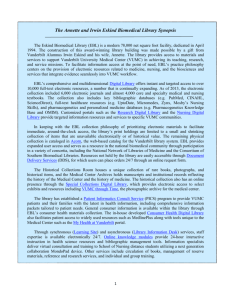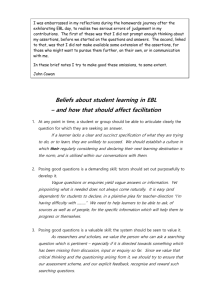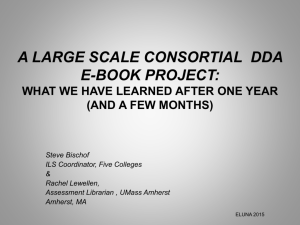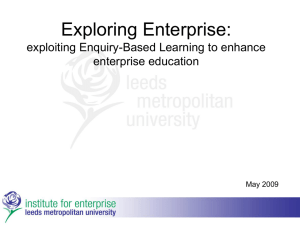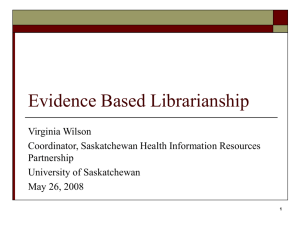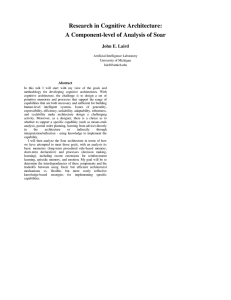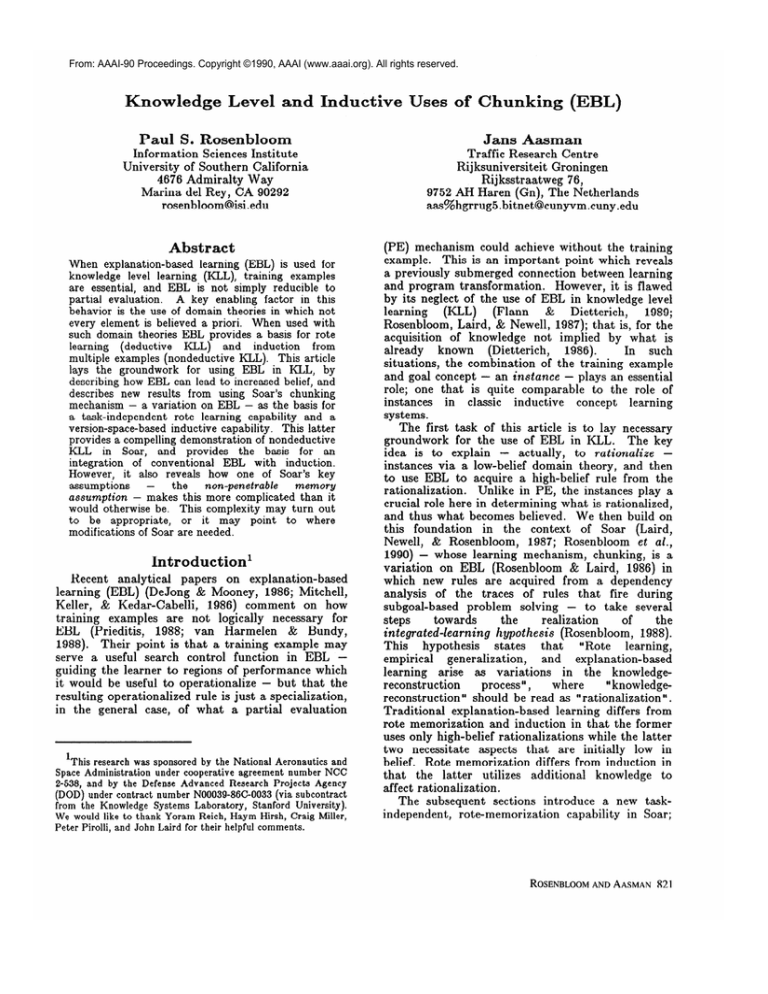
From: AAAI-90 Proceedings. Copyright ©1990, AAAI (www.aaai.org). All rights reserved.
Knowledge
Paul
Level
and Inductive
S. Rosenbloom
Information Sciences Institute
University of Southern California
4676 Admiralty Way
Marina de1 Rey, CA 90292
rosenbloom@isi.edu
Abstract
When explanation-based learning (EBL) is used for
knowledge level learning (KLL), training examples
are essential, and EBL is not simply reducible to
partial evaluation.
A key enabling factor in this
behavior is the use of domain theories in which not
every element is believed a priori. When used with
such domain theories EBL provides a basis for rote
learning (deductive
KLL)
and induction
from
multiple examples (nondeductive KLL). This article
lays the groundwork for using EBL in KLL, by
describing how EBL can lead to increased belief, and
describes new results from using Soar’s chunking
mechanism - a variation on EBL - as the basis for
a task-independent rote learning capability and a
version-space-based inductive capability. This latter
provides a compelling demonstration of nondeductive
KLL in Soar, and provides the basis for an
integration of conventional EBL with induction.
However, it also reveals how one of Soar’s key
the
non-penetrable
memory
assumptions
assumption - makes this more complicated than it
would otherwise be. This complexity may turn out
to be appropriate, or it may point to where
modifications of Soar are needed.
Introduction’
Recent analytical papers on explanation-based
learning (EBL) (DeJong & Mooney, 1986; Mitchell,
Keller, & Kedar-Cabelli,
1986) comment on how
training examples are not logically necessary for
EBL (Prieditis, 1988; van Harmelen & Bundy,
1988). Their point is that a training example may
serve a useful search control function in EBL guiding the learner to regions of performance which
it would be useful to operationalize - but that the
resulting operationalized rule is just a specialization,
in the general case, of what a partial evaluation
1
This research was sponsored
by the National Aeronautics
and
Space Administration
under cooperative
agreement
number NCC
Z-538, and by the Defense Advanced
Research
Projects
Agency
(DOD) under contract
number NOOO39-86C-0033
(via subcontract
from the Knowledge
Systems Laboratory,
Stanford
University).
We would like to thank Yoram Reich, Haym Hirsh, Craig Miller,
Peter Pirolli, and John Laird for their helpful comments.
Uses
of Chunking
(EBL)
Jans Aasman
Traffic Research Centre
Rij ksuniversiteit Groningen
Rijksstraatweg 76,
9752 AH Haren (Gn), The Netherlands
aas%hgrrug5.bitnet@cunyvm.cuny.edu
(PE) mechanism could achieve without the training
example. This is an important point which reveals
a previously submerged connection between learning
and program transformation.
However, it is flawed
by its neglect of the use of EBL in knowledge level
learning
(KLL)
(Flann
&
Dietterich,
1989;
Rosenbloom, Laird, & Newell, 1987); that is, for the
acquisition of knowledge not implied by what is
already
known
(Dietterich,
1986).
In such
situations, the combination of the training example
and goal concept - an instance - plays an essential
role; one that is quite comparable to the role of
instances in classic inductive
concept learning
systems.
The first task of this article is to lay necessary
groundwork for the use of EBL in KLL. The key
idea is to explain - actually, to rationalize
instances via a low-belief domain theory, and then
to use EBL to acquire a high-belief rule from the
rationalization.
Unlike in PE, the instances play a
crucial role here in determining what is rationalized,
and thus what becomes believed. We then build on
this foundation in the context of Soar (Laird,
Newell, & Rosenbloom,
1987; Rosenbloom et al.,
1990) - whose learning mechanism, chunking, is a
variation on EBL (Rosenbloom & Laird, 1986) in
which new rules are acquired from a dependency
analysis of the traces of rules that fire during
subgoal-based problem solving - to take several
towards
the
realization
of
the
steps
integrated-learning
hypothesis
(Rosenbloom, 1988).
This
hypothesis
states
that
“Rote
learning,
and explanation-based
empirical
generalization,
learning arise as variations in the knowledgeprocess”,
where
((knowledgereconstruction
reconstruction” should be read as “rationalization”.
Traditional explanation-based learning differs from
rote memorization and induction in that the former
uses only high-belief rationalizations while the latter
two necessitate aspects that are initially low in
belief. Rote memorization differs from induction in
that the latter utilizes additional knowledge to
affect rationalization.
The subsequent sections introduce a new taskindependent, rote-memorization
capability in Soar;
ROSENBLOOMANDAASMAN
821
extend this to induction from multiple examples,
providing a compelling example of nondeductive
knowledge level learning (NKLL) (Dietterich, 1986)
in Soar, and introducing a complication caused by
Soar’s inability to directly examine its own rules;
cover the third leg of the integrated-learning
hypothesis, explanation-based learning, and its use
in induction; and conclude.
EBL
and KLL
EBL can be applied over many types of domain
theories - the only requirement being the provision
by the domain theory of a way to generate a
(possibly generalized) dependency structure for the
instance that relates the training example to the
goal concept. In a classical EBL domain theory, all
of the elements - e.g., facts and rules - are
ascribed a uniform high level of belief. In such a
domain theory, EBL performs symbol level learning
by explicitly storing knowledge that is already
implicit in this domain theory. However, it does not
alter levels of belief - they are all already as high
as they can get. For knowledge level learning, the
domain theory needs to include low-belief elements.
With such a theory, EBL can lead to knowledge
level learning by increasing the level of belief in
selected elements of the theory.
Consider the example of a system with a domain
theory that allows it to abductively
generate
rationalizations - that is, plausible explanations for what it sees (or hears). One of the key ways in
which a rationalization
differs from a simple
deductive proof - as used in EBG (Mitchell, Keller,
& Kedar-Cabelli, 1986), for example - is that the
facts and rules utilized in a rationalization need not
be completely believed in order to be used. It is in
fact essential to the rationalization process that the
system be able to derive from its domain theory not
just facts that are known to be true, but also ones
which are not yet believed. For example, suppose
the instance consists of telling the system that
“Fred, a dolphin, is warm blooded” - “‘Fred is a
dolphin ” is the training example, and “Fred is
warm blooded” is the goal concept. To rationalize
this knowledge it might use that “dolphins are
mammals” and ((mammals are warm blooded”, even
if its a priori belief is that dolphins are fish rather
than mammals.
This explanation could have been
created in the absence of the instance, but it would
have little a priori believability.
It is the existence
of the instance that provides grounds for increasing
the believability of the explanation.
When this example is extended to the EBL/PE
situation, it becomes clear that arbitrary rules
created by partially evaluating this domain theory
would have low believability, while comparable rules
created by EBL for specific instances could have
much higher believability.
The instances allow EBL
to increase the scope of what is believed, thus
enabling knowledge level learning. In the extreme it
822 MACHINE LEARNING
is possible to start with a theory consisting of a
generator
able
to
produce
data
structures
representing all possible pieces of knowledge, all
with zero belief.
Such a theory has all possible
knowledge implicit in it, but none of it initially
believed.
EBL, in conjunction with appropriate
instances, can then be used selectively to learn
anything, by increasing the level of belief in the
appropriate, possibly implicit, knowledge structures.
One way to view this process is as explicit belief
propagation,
where there are belief-propagation
rules that are used to compute a level of belief for
an explanation - and thus for the rules learned via
EBL from the explanation - as a function of the
believability
of the individual
domain
theory
elements and the instance. An alternative view of
this process, and the one that guides the research
reported here, is that the instance acts as a filter,
letting through only those explanations which
should be believed.
Learning then only occurs for
these believed explanations.
To support this type of processing, plausible
domain theories - that is, theories in which only
plausible
explanations
can
be generated
for
conclusions - are required.
Such a theory can
potentially
explain things that aren’t true necessitating the use of instances as filters - but
what is true is explained in a plausible manner. As
long as a domain theory meets this condition, the a
priori believability of the individual elements of the
theory
can
be
zero
without
affecting
the
believability of what is learned.
At the extreme
end, the domain theory could contain elements
which are not representational in the domain, such
as the letter “d” - or which are representational
but do not have belief values, such as “‘dolphin” but which can be combined syntactically to generate
elements which do have belief values.
Given EBL and plausible low-belief
domain
theories, the one missing component is what makes
the newly learned rule believed.
A variety of
approaches
are possible,
including
ones that
augment the EBL mechanism to generate explicit
belief values, and ones that partition learned rules which automatically
receive high belief - from
domain theory rules. In Soar a variation on this
The domain theory
latter approach is used.
corresponds to the problem space used in a subgoal
(Rosenbloom & Laird, 1986) - in our case, this
might be a generation
problem space, where all
possible structures are generatable, but none are
believed.
However, the learned rule is always
created for the problem space in the parent goal;
perhaps a fact
problem
space, in which all
If restrictions
retrievable structures are believed.
are then placed on which problem spaces are utilized
at any point in time, it is possible to know what
level of belief - 0 or 1 - to assign to the retrieved
knowledge. This point is related to the one recently
made in (Flann & Dietterich, 1989). They focus on
how EBL can perform KLL if an explanation that is
generated for one concept is used to define a second
concept that is a specialization of the first one. In
our work, EBL performs KLL by transferring
(possibly implicit) structures from an unbelieved
domain theory to a believed domain theory that
contains a subset of the structures in the original
theory. Despite the differences, what both have in
common - in fact, what every use of EBL for KLL
must have in common is that the learned
knowledge is used differently than would be the
domain theory from which it is learned. It can be
used at a different belief level (as here), for a
different goal concept (Flann & Dietterich, 1989), or
even as evidence that a particular episode occurred
(in which the rule was learned) (Rosenbloom,
Newell, & Laird, 1990).
copy dependent on the structure of the cue graph
(solving the selective retrieval problem),
Figure 1
shows such a chunk, schematized as a pair of graph
structures.
The cue and recalled graphs are
attached to operator <Ol > in the rule’s conditions
and actions, respectively.
Rote Memorization
In previous work this general approach
to
knowledge level learning has been employed to
perform several simple rote memorization tasks recognition, recall, cued recall, and paired-associate
recall - for hierarchical letter strings and for
objects that are described by attributes with values
(Rosenbloom, Laird, & Newell, 1987; Rosenbloom,
Laird, & Newell, 1988; Rosenbloom,
Newell, &
Laird, 1990). This work also provided solutions for
two additional problems that arise when rules are to
be learned that recall new structure: (1) the data
chunking problem - how to enable the retrieval of
new information without its already being present and (2) the selective
retrieval
problem - how to
avoid retrieving everything ever learned. The data
chunking problem is solved by reconstructing new
knowledge from what is already known - that is,
the domain
theory
rather
than
directly
rationalizing the input structures representing the
new knowledge. Since this reconstruction process is
not dependent on the input structures, tests of the
input do not appear in the conditions of the learned
rules. The selective retrieval problem is solved by
selectively acquiring retrieval cues as conditions of
learned rules.
Recently, this earlier work has been extended
with the development of a general, task-independent
rote-memorization operator. This is a normal Soar
operator that uses problem solving in a subgoal to
implement solutions to the data chunking and
selective retrieval problems. The operator takes two
arbitrary graphs of Soar working memory elements
as inputs - the first is the training example, and
The result of
the second is the goal concept.
memorizing the pair is the acquisition of a rule that
tests for the existence of the first graph (the cue
graph) and if the test succeeds, retrieves the second
graph (the recalled graph) into working memory.
To do this, the memorization operator reconstructs
the recalled graph by assembling primitive domaintheory elements into a copy of the graph (solving
the data chunking problem), and then makes this
Figure
1: Chunk learned from memorizing
a pair of graph structures.
Multi-Example
Induction
When the contents of the initial domain theory
are restricted to only elements that are completely
believed, it is not possible for the domain theory
itself to perform inductive leaps.
If a system
containing such a domain theory is to perform
inductive generalization, it must be done outside the
domain theory - in the EBL mechanism, for
example.
The most common approach is to
augment EBL’s standard explanation processing
with some form of inductive postprocessing of either
the entire explanation,
or just its operational
components (Flann & Dietterich, 1989; Hirsh, 1989;
Sarrett & Pazzani, 1989).
If, on the other hand, the contents of the initial
domain theory can include unbelieved elements, the
option opens up of doing induction directly in the
domain theory, and leaving explanation processing
unaltered.
This was proposed in (Rosenbloom,
1988) as part of the integrated-learning hypothesis,
and is the approach taken here.’ The domain theory
includes knowledge
about how to reconstruct
presented objects (a stripped-down version of the
task-independent
memorization
operator),
generalization hierarchies (the basis of the concept
language), rules which perform inductive leaps, and
rules learned from prior instances.
When a new
instance is perceived, this domain theory is used to
determine what is to be rationalized - it may be a
generalization of the instance, rather than the
instance itself - as well as how it should be
rationalized.
ROSENBLOOMANDAASMAN
823
One decision that must be made at this point is
the orientation of the rule to be learned - whether
the concept’s name should be in the actions and its
definition in the conditions, or vice versa. In EBL
(and chunking), the concept definition appears in
the conditions because that is where EBL has its
primary generalization effect, and also where the
definition can act as a recognizer of instances of the
However, to go beyond simple concept
concept.
recognition - to retrieval and modification of the
concept definition as further instances are processed
requires a fuller declarative
access to the
definition.
Such access is not available in Soar if
the definition is stored in the conditions because
Soar’s rule memory is non-penetrable
- rules can be
but can not be directly
executed
(forward),
Non-penetrability
arises because the
examined.
rules are compiled procedures that can be executed
In psychological terms, they
but not examined.
example,
automatized
behavior
(for
represent
(Shiffrin & Schneider, 1977)).
A consequence of
non-penetrability
is that, to access the concept
definition explicitly, it must be stored in the rule’s
actions, where it can be retrieved by rule execution.
Once retrieved, the concept definition can be used to
influence what is learned for new instances, and to
interpretively recognize instances of the concept
(concept recognition rules, in which the definition is
in the conditions, can be learned by chunking this
As discussed later, the
interpretation process).
downside of this decision is that the generality of
the concept definition is affected only by the
decision of what to rationalize, and not by the
the
chunking/EBL
process
or
rationalization
mechanism.
The domain theory that has been implemented
within Soar utilizes a variant of the Focussing
algorithm (Young, Plotkin, & Linz, 1977; Bundy,
Silver, & Plummer, 1985). This is a version space
’ algorithm that works for spaces describable by a
conjunction of attributes, where each attribute is
generalization
defined
by
a
tree-structured
The
key
ideas
underlying
the
hierarchy.
implemented algorithm are that: (1) the version
space is kept factored - bounds are maintained
independently for each attribute (Subramanian &
1986); (2) only near-miss negatives
Feigenbaum,
(Winston, 1975) are processed (the zero option)3 to
guarantee that the boundary sets will not fragment;
and (3) once the first positive example is processed,
the entire factored
version space is explicitly
represented, rather than just the boundary sets (at
worst this requires space proportional to the number
of attributes times the maximum depth of the
generalization hierarchies).
Suppose that the task is to learn that the
definition
of
(GOOD=TRUE) is
(MOBILITT=MOBILE,
3
order, fat misses are not needed
With a suitable training
convergence
(Bundy, Silver, & Plummet,
1985).
824 MACHINE LEARNING
for
SHAPE=ANY, SIZE=ANY). The algorithm starts with the
goal concept, (GOOD=TRUE), and a positive example,
such
as
(MOBILITY=WHEELED,
SHAPE=SQUARE,
uses the generalization
SIZE=LARGE).4 It then
hierarchies in the domain theory to elaborate the
example with all of the superclasses of its attributes’
values, yielding for this case (MOBILITY=CANY,MOBILE,
WHEELED), SHAPE=(ANY, POLYGON, REGULAR, SQUARE),
SIZE=<ANY, LARGE)). This elaborated example is then
memorized as the initial version space, with the
retrieval cue being the goal concept:
(GOOD=TRUE) -->
(MOBILITY=(ANY, MOBILE, WHEELED),
SHAPE=<ANY, POLYGON, REGULAR, SQUARE),
SIZE=(ANY, LARGE))
The memorization a operator succeeds here only
because the initial domain theory implicitly contains
within itself every possible version space that could
be generated for (GOOD=TRUE),all initially unbelieved.
The example then determines which of these version
spaces is explicitly stored, and thus believed.
When a succeeding positive example of this same
goal concept is encountered, processing again begins
by elaborating it with its values’ superclasses. The
current version space for the concept is then
retrieved and compared to the elaborated example.
All value classes in the concept version space that
are not also in the elaborated example are then
rejected from the version space (a form of
incremental version space merging (Hirsh, 1989)).
Chunking over this rejection process yields rules
which, in the future, reject the inappropriate
segments of the old version space. This rejection
process is itself reconstructive so that the updated
version space can later be retrieved without the
presence of the positive example.
As an example, suppose that the next example for
(MOBILITY=TRACKFD,
goal
concept
is
this
SHAPE=ELLIPSE, SIZE=LARGE), which when elaborated
MOBILE,
TRACKED),
(MOBILITY=(ANY,
becomes
SHAPE=(ANY, CONIC, ELLIPSE), SIZE=(ANY, LARGE)).
From this example, the following rejection rules are
learned:
(GOOD=TRUI~,
MoBILIn=WHEIu3D) --->
(GOOD=TRUE, sHApE=poLYGoN) --->(SHAPE=POLYG~N)(GOOD=TRUE, SHAPE=REGULAR) ---> (SHAPE=REGULAR)(GOOD=TRUE, SHAPE=SQUARE) ---> (SHAPE=SQUARE)-
The next time the same goal concept is seen, all five
learned rules fire, yielding the following updated
version space: (MOBILITY=CANY, MOBILE), SHAPE=ANY,
SIZE=(ANY, LARGE)).
Learning from negative examples introduces an
additional issue: because all of the knowledge
learned from positive examples is cued off of
4
and all later
This example,
Soar (Version 5.0.2), and verified
ones have been implemented
to run correctly.
in
(GOOD=TRUE), it will not be retrieved automatically
for a negative example, where (GOOD=FALSE) (the
converse is also true).
The solution to this is to
transiently cue with both TRUE and FALSE, thus
retrieving all of the knowledge so far learned about
the concept, and then to proceed to process the
example while maintaining only the correct value
(FALSE,in this case). Then, if the example is a nearmiss - that is, if it mismatches in at most one
attribute
those classes of the mismatched
attribute that match are rejected from the version
space. If the example is a far miss, it is ignored.
As an illustration, suppose the third example is
negative
example
(MOBILITY=STATIONARY,
the
This example is
SHAPE=REcTANGLE, SIZE=LARGE).
elaborated with superclass information to become
(MOBILIT~=<ANY, STATIONARY), SHAPE=<ANY, POLYGON,
IRREGULAR, RECTANGLE>, SIZE=<ANY, LARGE)),and then
about
the
concept
the existing
information
definition is retrieved. The mismatched attribute is
MOBILITY, and the class that matches for that
attribute is ANY. The rule learned for rejecting this
class is:
(GOOD=FALSE, MOBILITY=ANY) --> (MOBILITY=ANY)-
The
resulting
concept
version
space
is
(MOBILITY=MOBILE, SHAPE=ANY, SIZE=<A~, LARGE)).
These examples demonstrate that Soar can be
used not only as the basis for rote memorization
but
deductive
also
for
induction
Kw,
Inductive augmentations of
Inondeductive KLL).
the EBL mechanism are not required, because the
induction occurs directly in using the domain
theory.
As suggested by the integrated-learning
rote
learning
and induction
are
hypothesis,
distinguished by differences in the rationalization
process.
However, contrary to the intent of the
hypothesis, the difference is in terms of what is
rationalized rather than how it is rationalized
(forced
by the decision to store the concept
definition in actions rather than conditions). In the
induction case, rather than directly rationalizing the
concept name in terms of the training example, it is
rationalized
in terms of the version space (or
changes to it). This choice of what to rationalize is
essentially a choice of what to learn. Here, this
choice was based on the instance, the generalization
space,
and
the previous
version
hierarchies,
knowledge about how to induce.
Bringing other
knowledge to bear should allow additional useful
variations on this choice.
Explanation-Based
Learning
Using the chunking/EBL mechanism to perform
explanation-based learning - that is, the standard
form of symbol level learning - supports the third,
and final leg of the integrated learning hypothesis.
However, this needs no explicit demonstration here,
as it is the foundational result of EBL.
Instead,
what is of interest here is the extent to which, in
practice, this use of EBL can be integrated with the
induction process described in the previous section.
In this section we examine three successively weaker
versions of this question.
The first version is
whether the direct use of EBL in induction, as
described in the previous section, provides the
requisite form of symbol level learning - that is, is
EBL
itself
performing
significant
acts
of
“justifiable” generalization during induction?
The
answer, upon inspection, is “no”.
EBL is storing
the results of inductive processing, but it is not itself
contributing to their level of generalization. This is
forced by the decision to store the concept definition
in rule actions.
The second version is whether the standard use of
EBL to perform symbol level learning - that is,
with a classical believed domain theory - can help
the inductive process described in the previous
section (which is independently using EBL).
The
answer to this version of the question is once again
I’no ‘I. To see this, consider a domain theory with
the following two believed rules.
(MOBILITY=WHEELED)--B @AST=TRUE)
(FAST=TRW swpE=co~~c) ---a (GOOD=TRIJE)
If these rules are used to relate the training example
to the goal concept, the following rule is learned.
This is exactly what EBL should learn. However, it
is difficult to use in the induction process described
in the previous section because the generalized
example is in the conditions of the rule - thus the
rule retrieves the goal concept when a matched
training example is present, rather than retrieving
the generalized example when the goal concept is
present. This failure is disturbing because this is
the type of gain achieved
by other hybrid
approaches, such as (Flann & Dietterich, 1989;
Hirsh, 1989; Sarrett & Pazzani, 1989).
In these
other approaches, this problem is solved by enabling
the induction
process to directly
access the
explanation, its operational fringe, or the resulting
rule. In the present approach, the rule can be fired,
but neither it nor any part of the explanation can
be directly examined.
The third version is whether some form of
learning
can
lead
to
explanation-based
generalizations that are useful in the induction
process described in the previous section.
The
answer here is finally ‘(yes”.
However, it requires
augmenting the domain theory itself with the ability
to interpret rules and to generate and process
explanations.
These rules are not Soar’s native
rules,
but
declarative
structures
of
limited
expressibility that are stored in the actions of Soar’s
rules.
These rules are retrieved as needed to
support a backward-chaining
process that starts
with the goal concept and ends when it grounds out
in attribute-value pairs contained in the elaborated
The
example
(the
operational
predicates).
ROSENBLOOMAND AASMAN 825
operational fringe of the explanation derived from
this process is a generalization of the example.
Based on the approach in (Hirsh, 1989), this
generalized
example is used in induction
by
converting it into an explicit, factored version space
- by assigning values to unmentioned attributes
({ANY} for positive examples, and the values in the
concept version space for negative examples) and
then elaborating it with superclasses - and then
merging it with the current concept version space.
As illustration, consider the positive example
(MOBILITY=WHFELED,
which
becomes
upon
SHAPE=CIRCLE,
elaboration
SIZE=SMALL),
(MOBILITY=WJY,
CONIC, CIRCLE),
MOBILE, WHEELED>, SHAPE=<ANY,
SIZE=UNY, SMALL)). If the domain theory consists of
the two rules above, backward chaining yields an
operational
fringe
of
(MOBILITY=WHEELED,
SHAPE=CONIC), which is more general than the
original example because it ignores SIZE, and
generalizes SHApE from CIRCLE to CONIC. When this
generalized example is extended to cover the
unmentioned attributes, and elaborated, it becomes
(MOBILITY=<ANY, MOBILE,
CONIC), SIZE=ANY). When
WHEELED),
SHAPE=<ANY,
this description is then
merged with the concept version space, the result is
(MOBILITY=MOBILE, SHAPE=ANY, SIZE=ANY). The rule
learned from this processing is:
(GOOD=TRUE) ---, (SIZE=LARGE)-
This same general approach can be used to
incorporate other forms of knowledge into the
induction
process.
So far, we have partial
implementations of the use of irrelevance knowledge
(Subramanian
&
Genesereth,
1987)
and
determinations (Davies & Russell, 1987; Mahadevan,
1989; Russell, 1988; Widmer, 1989) in the induction
process.
When taken together, the answers to the three
versions of the question reveal that explanations can
be effectively
combined with induction in this
approach, but that this is achieved only by building
additional declarative rule interpretation and EBL
The native
mechanisms into the domain theory.
mechanisms are not usable because there is no way
to access the rules (or explanations) they create as
declarative structures, as required by the induction
process.
The question this raises is whether this is
evidence that the Soar architecture needs to be
that some
of our
changed
or is evidence
preconceived
notions
about induction,
and its
interaction with chunking/EBL, need to be changed.
While the former is a distinct possibility, the utility
of architectures as theories of intelligence stems in
large part from their ability to predict unexpected
but important phenomena.
If the architecture is
changed whenever one of its consequences violates
Also
preconceived notions, this benefit is lost.
potentially lost are the positive consequences of the
way the changed component currently works. The
component is usually the way it is for good reason,
826 MACHINELEARNING
which in this case is the ability to model basic
aspects of human memory. Thus it is useful, before
jumping in and changing the architecture, to first
consider the possibility
that Soar is revealing
something important here. When this is done, at
least one intriguing speculation
arises that
chunking
and EBL, though
quite similar in
mechanism (both compile dependency structures),
are really distinct capabilities.
Chunking is an
automatic architectural process (it learns for every
result of every subgoal, and does not compete for
cognitive resources with performance),
of fixed
capability (how it works is not affected by what the
system knows), which compiles recognition-driven
procedures (productions) from experience. It is an
appropriate,
and effective, generalized long-term
caching mechanism; but it really is a low-level
mechanism that is in some ways more analogous to
neural-network learning algorithms than to EBL.
However, an intelligent system also needs to be able
to deliberately
create
and utilize declarative
explanations of new phenomena.
This is where
EBL, as used here in concept learning, comes in. It
is a deliberate cognitive process, of open capability,
which processes and creates declarative structures
that can be used in induction, and which can also
yield
behavior,
but
only
indirectly,
through
interpretation.
Conclusions
By making a distinction between what is in the
domain theory (either implicitly or explicitly) and
what is believed, it is possible to distinguish the
symbol level and knowledge level uses of EBL symbol level uses make implicit knowledge explicit,
while knowledge
level
uses make unbelieved
knowledge believed.
This idea has been explored
here as the foundation for chunking(EBL)-based rote
memorization
(deductive
KLL)
and induction
(nondeductive
KLL)
capabilities.
Utilizing
enables induction to be
unbelieved
knowledge
performed in the domain theory itself, rather than
as a post hoc process.
Chunking is used in this
induction process to store the initial version space,
and to record modifications to it that are required
by new instances of the concept. These capabilities
demonstrate why EBL is not simply reducible to
partial evaluation - the training examples are
essential.
When combined with the standard use of EBL for
symbol level learning, these capabilities provide the
three legs of support required by the integrated
learning hypothesis.
However, the support is
weakened by the difference between rote learning
and induction arising from differences in what is
rationalized rather than how it is rationalized.
Further weakening is engendered by the difficulty in
using EBL to generalize instances for use by
induction. This has been accomplished, but only by
additional
declarative
EBL
implementing
an
mechanism in the domain theory.
Both of these
weaknesses occur because of the choice to store the
inductive concept definition in the actions of learned
rules (rather than in the conditions), which is itself
forced by the non-penetrability of Soar’s rules, and
the resulting difficulty in determining the contents
As discussed in the previous
of rule conditions.
section,
this may actually
turn out to be
appropriate, or it may reveal an aspect of Soar that
should be altered.
References
Anderson, .I. R. 1986. Knowledge compilation: The
general learning mechanism.
In R. S. Michalski,
J. G. Carbonell, & T. M. Mitchell (Eds.), Machine
An Artificial
Intelligence
Approach,
Learning:
Los Altos, CA: Morgan Kaufmann
Volume II.
Publishers, Inc.
Bundy, A., Silver, B., & Plummer, D. 1985. An
comparison
of
some
rule-learning
analytical
programs. Artificial
Intelligence,
27, 137-181.
Davies, T. R., & Russell, S. J.
approach to reasoning by analogy.
IJCAI-87.
Milan.
logical
Proceedings
of
1987. A
DeJong, G., & Mooney, R. J. 1986. Explanationbased learning: An alternative view. Machine
Learning, 1, 145-176.
Dietterich, T. G. 1986. Learning at the knowledge
level. Machine Learning, 1, 287-315.
Flann, N. S., & Dietterich, T. G. 1989. A study of
explanation-based methods for inductive learning.
Machine Learning, 4, 187-226.
Hirsh, H. 1989. Combining empirical and analytical
learning with version spaces.
fioceedings
of the
Sixth
International
Workshop
on
Machine
Learning.
Cornell.
Laird, J. E., Newell, A., & Rosenbloom,
Soar: An architecture
for general
Artificial
Intelligence,
33, l-64.
P. S. 1987.
intelligence.
Mahadevan, S. 1989. Using determinations in EBL:
A solution to the incomplete
theory problem.
fioceedings
of the Sixth
International
Workshop
on Machine Learning.
Cornell.
Mitchell, T. M., Keller, R. M., & Kedar-Cabelli,
S. T.
1986. Explanation-based
generalization: A
unifying view. Machine Learning, -1, 47-80.
Prieditis, A. E. 1988. Environment-guided program
transformation.
G. F. DeJong (Ed.), Fkoceedings of
the
AAAI
Symposium
on Explanation-Based
Learning.
Stanford, CA: AAAI.
Rosenbloom, P. S.
search: Towards
acquisition of new
Proceedings
of
Explanation-Based
1988. Beyond generalization
as
a unified framework
for the
knowledge. G. F. DeJong (Ed.),
the
AAAI
Symposium
on
Learning.
Stanford, CA: AAAI.
Rosenbloom, P. S., & Laird, J. E.
1986. Mapping
explanation-based
generalization
onto
Proceedings of M-86.
Philadelphia.
Soar.
Rosenbloom, P. S., Laird, J. E., Newell, A., &
R.
1990. A preliminary analysis of the
Soar architecture as a basis for general intelligence.
Artificial
Intelligence,
. In press.
McCarl,
Rosenbloom, P. S., Laird, J. E., & Newell, A. 1987.
Knowledge level learning in Soar. Proceedings
of
M-87.
Seattle.
Rosenbloom, P. S., Laird, J. E., & Newell, A. 1988.
The chunking
of skill and knowledge.
In
B. A. G. Elsendoorn & H. Bouma (Eds.), Working
Models of Human Perception.
London: Academic
Press.
Rosenbloom, P. S., Newell, A., & Laird, J. E. 1990.
Towards the knowledge level in Soar: The role of
the architecture in the use of knowledge.
In
K. VanLehn (Ed.), Architectures
for Intelligence.
Hillsdale, NJ: Erlbaum. In press.
Russell,
S. J.
Tree-structured
1988.
fioceedings
of AAAI-88.
St. Paul, MN.
bias.
Sarrett, W. E. & Pazzani, M. J. 1989. One-sided
algorithms
for
integrating
empirical
and
explanation-based
learning.
Proceedings
of the
Sixth
International
Workshop
on
Machine
Cornell.
Learning.
Shiffrin, R. M. & Schneider, W. 1977. Controlled
and automatic human information processing: II.
Perceptual learning, automatic attending, and a
general theory. Psychological
Review, 84, 127-190.
Subramanian,
D., & Feigenbaum,
Factorization
in
experiment
fioceedings
of AAAI-86. Philadephia.
J.
1986.
generation.
Subramanian, D., & Genesereth, M. R. 1987. The
relevance of irrelevance. Proceedings
of IJCAI-87.
Milan.
van Harmelen, F. & Bundy, A. 1988. Explanationpartial
evaluation.
based
generalization
=
Arti jicial Intelligence,
36, 401-412.
Widmer, G. 1989. A tight integration of deductive
and inductive learning.
Proceedings
of the Sixth
International
Workshop
on Machine
Learning.
Cornell.
Learning structural
Winston,
P. H.
1975.
descriptions
In
Winston,
from
examples.
P. H. (Ed.), The Psychology
of Computer
Vision.
New York: McGraw Hill.
Young, R. M., Plotkin, G. D., & Linz, R. F.
Analysis of an extended concept-learning
FFoceedings of IJCAI-77.
Cambridge.
ROSENBLOOMANDAASMAN
1977.
task.
827


